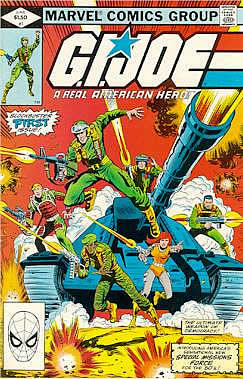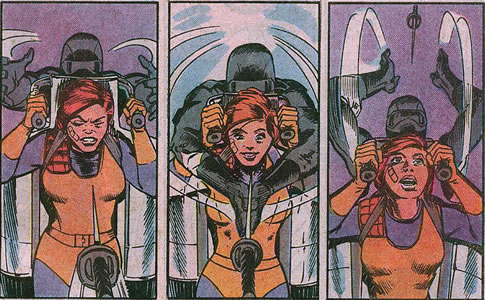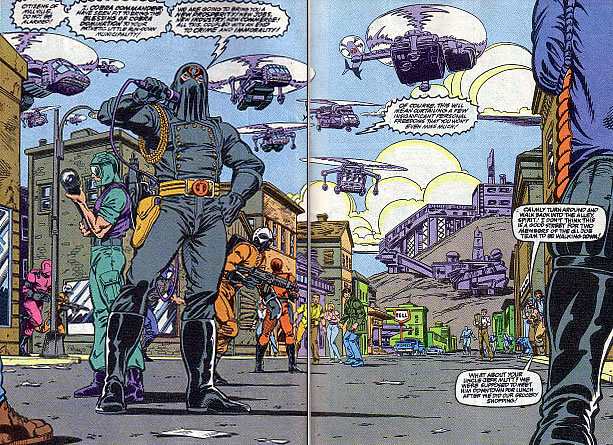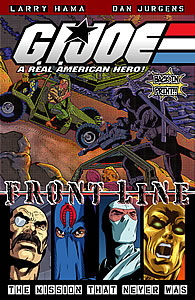Few people have had the impact on "GIJoe: A Real American Hero" that Larry Hama has. Author of the majority of the RAH-era file cards, as well as the plurality of the Marvel Comics issues, he placed a human face on a diverse group of "toy line" characters. Now, Mr. Hama returns to the "original 13" in the GIJoe: Declassified mini-series from Devil's Due Publishing. JoeBattlelines would like to thank Mr. Larry Hama for taking time out of his busy schedule to sit down and answer a few questions about his work—past, present, and future.
GIJoe – The Marvel series:

JoeBattlelines: In the very beginning, GIJoe almost had a “Shield vs. Hydra” vibe to it. Was it difficult writing stories in a universe that was essentially a blank page at the time?
Larry Hama: I was terrified that I would run out of ideas by the third issue. I pretty much did. I didn’t really get rolling until I fully understood that it was all about the characters and not the plot.
JBL: In issue #1, like much of the Marvel series, the Joes come across as believable realistic people as opposed to over-the-top superheroes. The characters, in spite of the situations, have always been portrayed as “human”. Do you think this is a factor in enduring appeal of the cast of GIJoe?
LH: I would think so. I believe there is something inherently fascist about super-heroes. After all, they are better than the rest of us and putting themselves above the law to do something about it. A soldier is bound by a code of conduct, international law, and hopefully, honor.
JBL: In the earliest issues of the Marvel series, Scarlett and Snake Eyes were not yet revealed as a couple. (She actually had more “panel time” with Clutch!) Was the relationship between Ms. O’Hara and Joe’s most iconic character intended from the beginning or was it more of a natural evolution of the characters?
LH: It was gradual. At first there was no real thought about pairing up any characters. It was hard enough just getting through the action.
JBL: At times, the comic series roster seems to have been heavily influenced by the current offerings from Hasbro (Eco-Warriors, Ninja Force, etc) yet characters like Lady Jaye remained throughout the entire run, in spite of only having one figure released. How much freedom did you have in terms of character choice for any given issue?
LH: If a female character showed up, she pretty much stuck around no matter what! There were so few to work with! Hasbro would want the latest figures spotlighted, of course, but they didn’t pressure me about using the existing stable in any way I chose.

JBL: You’ve probably answered this question a million times before but are you surprised by the popularity of “Silent Interlude” over many of the other stories you wrote?
LH: That took a long time in coming. At first, readers hated it. They felt cheated that there were no words, that it could be “read” too quickly. That issue got LOTS of negative mail. But then, so did the annual that was drawn by Michael Golden. Readers complained that the drawing was too “cartoony.”
JBL: Do you have a favorite storyline from the Marvel run? If so, which one?
LH: The origin of Snake-Eyes and the battle of Cobra Islands were the most fun to write.
JBL: Are you referring to the Cobra Civil War (#74 - #76) or the creation of Cobra Island (#40)? It always seemed that no matter when the Joes set foot on that island, it always ended badly for them.
LH: The stuff that was done by Marshall Rogers and Ron Wagner. (Marvel GIJoe: A Real American Hero #74 - #76)
JBL: In the comic, Hawk was very much the central authority of the GIJoe team. The cartoon initially delegated command of the team to Duke, with Hawk showing up significantly later in the series. Was there any pressure to sideline Hawk in favor of the First Sergeant?
LH: Well, Hasbro was kind of honked about having a character named Hawk because of the political implications. That implication hadn’t even occurred to me. I was only concerned that it made no sense for the First Shirt to be in charge. The top sergeant runs the company, but it belongs to the commanding officer, who is ultimately responsible.

JBL: I was surprised as a young reader when Cobra Commander was killed in issue #61. When he returned in issue #100, he seemed “changed”—more outlandish than the calculating former used car salesman we’d come to know. Was this an intentional shift in the character’s personality?
LH: It wasn’t planned. I guess it just happened. Maybe I was the one who changed. I was mighty honked about having been forced to kill off one our favorite characters to make the continuity match up to of all things, COBRA LA! It was because of stuff like that that I refused to watch any of the GI Joe animated material. I still have not seen any of it.
JBL: Going back to #61 for a moment, this was the issue that began the whole Borovia storyline involving Stalker, Quick Kick, Snow Job, and Outback where the latter is ordered to leave his comrades behind in order to get the message out regarding what really happened. It’s a very dark storyline- with the death of Spigou, the capture and torture of the Joes, and Outback’s chilly reception back at the PITT. Was there ever any concern that the storyline might be deemed “too dark” for a “children’s” comic?
LH: Was that actually any darker than the death of Kwinn? Also, why shouldn’t dark things happen in “children’s” reading material? Ever read the original Grimm’s Fairy Tales? In Robert Louis Stevenson’s “ Treasure Island” the child protagonist shoots a pirate in the face with flintlock pistol among other non PC actions. Times have changed! I remember as a kid, seeing illustrations in Bible stories for children of young David chopping off the fallen Goliath’s head. There was a particularly gruesome drawing or engraving of Absalom and the tree that gave me nightmares. It’s too easy to forget that the purpose of showing these dark events is to demonstrate that it is possible to triumph over them. Yes, bad things happen to good people, but we get over them and we move on, and we are stronger.
JBL: Is it daunting as a writer to encounter so many fans that hold your work in such high regard? I’ve talked to many Joe fans who credit your work on the Marvel comic as one of the reasons that they enlisted in the US Armed Forces. Did you ever imagine that a comic based on a toy line would have such a profound impact on so many?
LH: It was not something I wished to think about during the First Gulf War. It is a haunting responsibility. But, I have yet to receive a letter from a soldier saying I led them on or misrepresented the bad side.
GIJoe: Frontline – “The Mission that Never Was”

JBL: Were you surprised when Devil’s Due approached you to write for the Frontline comic series?
LH: Yes.
JBL: The tone of the story is very “retro”—fitting in perfectly with the feel of stories from the end of the Marvel run. Was it difficult to go back and pick up writing in that particular style again?
LH: No. That’s my style. I’m a retro sort of guy. An editor at Marvel once said that my work was “old fashioned” because my stories actually made sense. I didn’t realize until much later that he wasn’t intending that as a compliment.
JBL: It was good to see General Colton again (as well as Jane) in this story. The two characters were fairly consistent recurring characters at the end of the Marvel run. Are they possibly favorites of the author?
LH: I liked them because they seemed like normal real people, especially the way they were drawn by Marshall Rogers.
JBL: By the way, thanks for including Gung-Ho in the story. He’s always been a favorite of mine! Is there any significance to the roster that you chose for this storyline?
LH: There was never any significance to any roster.
JBL: Once again, we see characters under the influence of the Brainwave Scanner—a device which dates all the way back to Dr. Venom. Was this always intended as a long-term plot device?
LH: Never thought that thing would be used again. Definitely thought it was a one time item, but it kept wanting to come back. Like Kwinn. I called the BWS my Deus Ex Machine.
JBL: Do you feel that this story adequately resolved any dangling plotlines from the Marvel run?
LH: Any? Some. Many more left dangling. What happened to Zartan?

